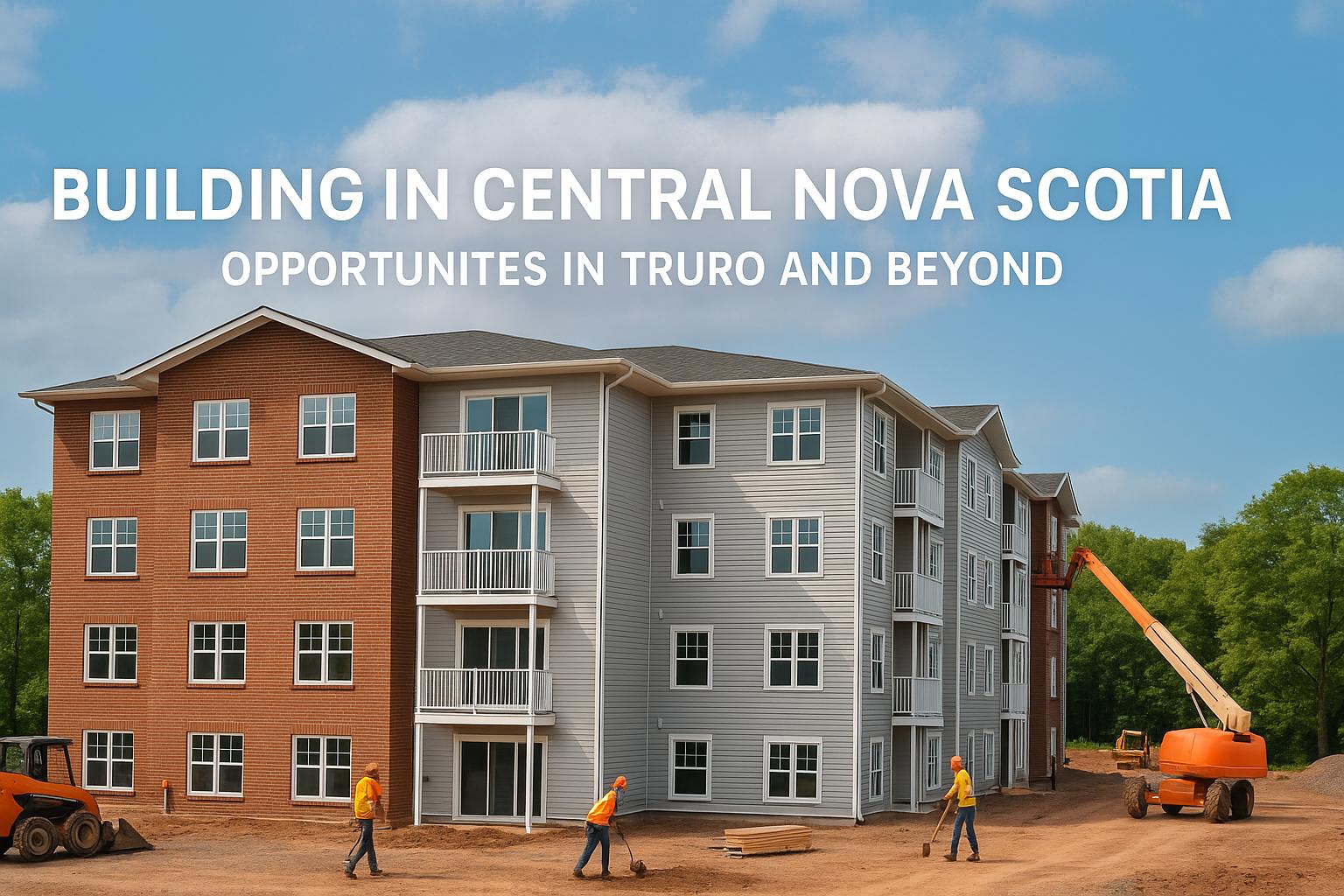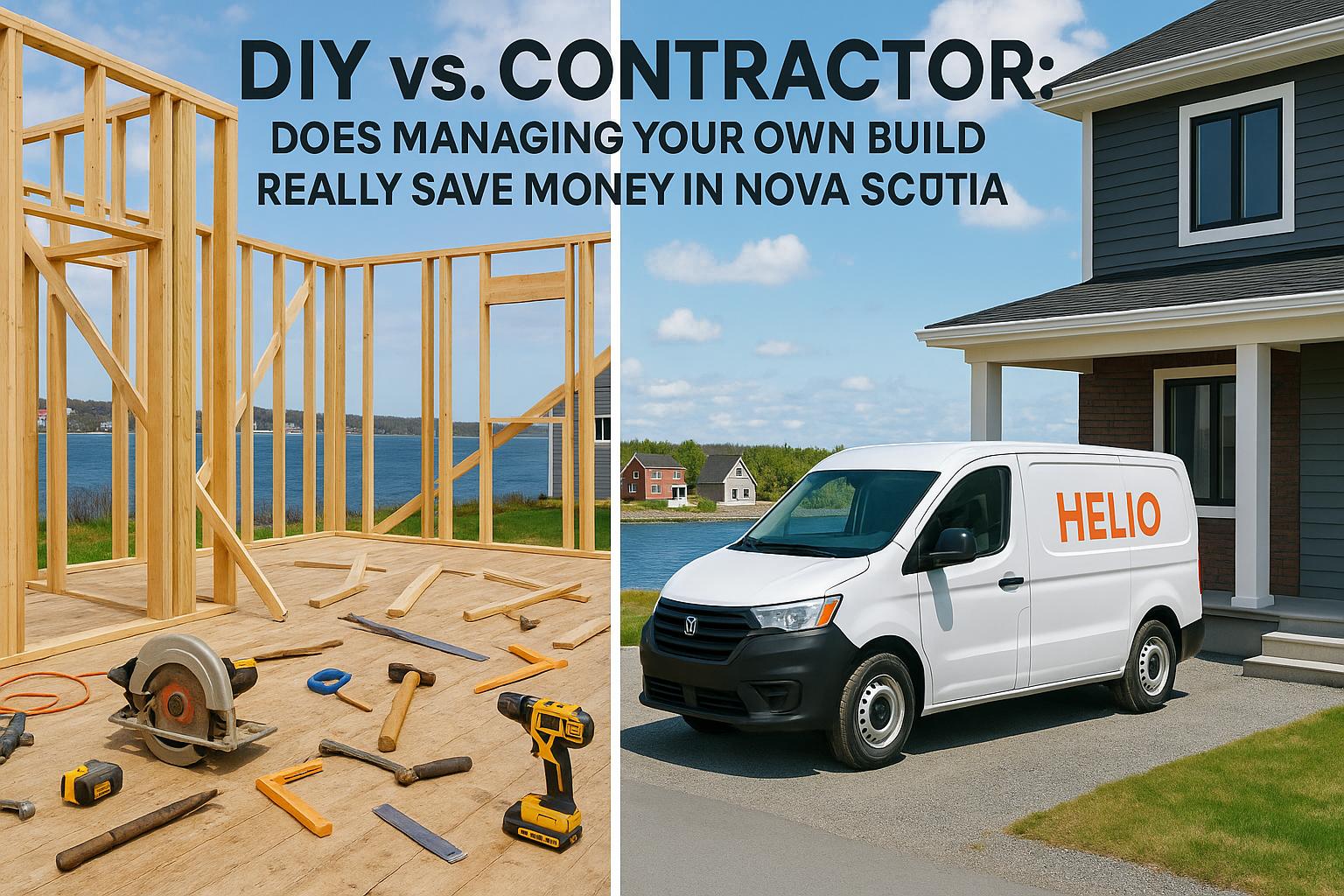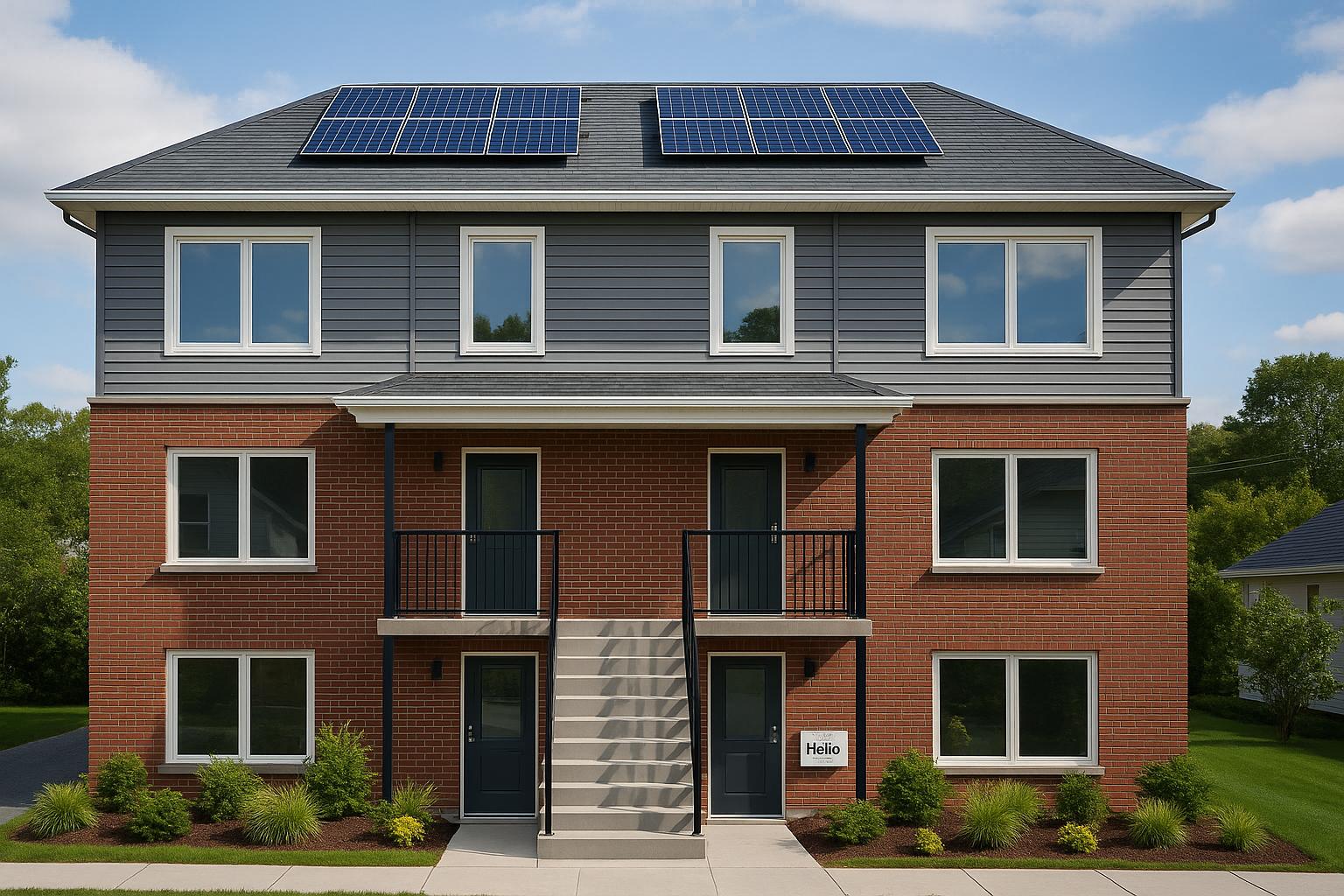Nova Scotia is seeing a growing interest in tiny homes as a solution to rising housing costs, particularly in Halifax, where many residents spend 30–40% of their income on rent. Recent changes to building codes and zoning rules make it easier for builders and property owners to add these small, affordable units to their properties. Here's what you need to know:
- New Regulations: Provincial building codes now include specific safety and energy efficiency standards for tiny homes. Municipal zoning rules vary, with urban areas like Halifax allowing tiny homes as secondary units, while rural areas offer more flexibility.
- Types of Tiny Homes: Permanent (foundation-based) units follow standard permit and tax rules, while mobile units face different requirements, such as parking and utility connections.
- Market Trends: Demand is driven by young professionals, retirees, seasonal workers, and new Canadians. Popular features include loft sleeping areas, energy-efficient heating, and smart home technology.
- Multi-Unit Developments: Property owners are increasingly adding multiple tiny homes to single lots to maximize rental income. Shared amenities like laundry and parking enhance tenant appeal.
- Construction Tips: Integrated design-build methods reduce delays, control costs, and ensure quality. This approach streamlines the process by consolidating all aspects of construction under one team.
Tiny homes in Nova Scotia are not just a housing trend - they're a scalable opportunity for builders and property owners to address affordability while boosting rental income. By following local regulations and using efficient construction methods, you can tap into this growing market.
Why these tiny homes are more than just housing
Nova Scotia's New Tiny Home Regulations Explained
Navigating Nova Scotia's rules for tiny homes is essential for builders and property owners alike. The province has rolled out new guidelines that set tiny homes apart from traditional housing, opening up fresh possibilities while outlining clear compliance standards. Here's how provincial and municipal regulations, along with permit requirements, influence tiny home construction.
Provincial Building Code Changes
Nova Scotia has introduced specific construction standards to ensure tiny homes are both safe and functional.
The updated provincial building code includes enhanced fire safety measures tailored to these compact dwellings. These include dedicated egress requirements and improved smoke detection systems, ensuring that even the smallest structures provide adequate protection for residents. Energy efficiency standards have also been strengthened, mandating that tiny homes meet or exceed insulation and heating benchmarks to ensure year-round comfort.
Given the size constraints of tiny homes, full accessibility standards can be challenging to implement. To address this, the guidelines recommend incorporating basic accessibility features where feasible, striking a balance between practicality and inclusivity.
Municipal Zoning Rules by Location
Municipal zoning bylaws add another layer of regulation, varying significantly across Nova Scotia.
In urban areas like Halifax Regional Municipality, tiny homes are often permitted as secondary dwelling units within designated residential zones. However, these permissions come with specific conditions, such as minimum lot sizes and placement criteria. Rural municipalities, on the other hand, tend to offer more flexibility, particularly when tiny homes serve as accessory units on existing properties. Builders must pay close attention to local setback requirements and zoning details, as these can differ widely between municipalities.
Some municipalities are running pilot programs to test how tiny homes fit into established communities. These initiatives often simplify the approval process but may include unique design and placement restrictions. Density rules also vary: while some regions allow multiple tiny homes on larger lots, others limit installations to a single unit per property, which can significantly impact plans for multi-unit developments.
Permit Requirements: Wheels vs Foundation
The type of tiny home - mobile or permanent - affects permits, taxes, and other obligations.
For permanent tiny homes built on foundations, standard permitting and taxation rules apply. These homes must comply with all relevant building codes, including those for utility connections, and are treated as permanent dwellings under zoning and property tax laws.
Wheeled tiny homes, however, face a different set of challenges. While they may sidestep some traditional permit requirements, they often encounter parking restrictions and must usually connect to approved water and sewer systems. The timeline for obtaining permits also varies depending on whether the unit is mobile or foundation-based, as each category follows distinct review processes. Understanding these differences is essential for effectively planning projects, especially for those considering multi-unit rental developments.
Current Trends in Nova Scotia's Tiny Home Market
Nova Scotia's tiny home market is growing steadily as more residents turn to affordable, flexible living options. This shift is largely influenced by changing lifestyle needs, offering opportunities for builders and property owners to tackle housing challenges while catering to a range of demographics. Below, we explore the key factors driving demand, popular design trends, and the rise of multi-unit developments in the province.
What's Driving Demand: Cost and Demographics
Skyrocketing housing costs are prompting many Nova Scotians to explore tiny homes as a more affordable alternative. Young professionals and remote workers, in particular, are drawn to the flexibility and efficiency that tiny home rentals provide in urban areas.
At the same time, Nova Scotia’s aging population is fuelling demand. Retirees looking to downsize while maintaining their independence often find tiny homes ideal as secondary units on family properties. Seasonal workers in industries like tourism and fishing also see tiny homes as a practical solution for temporary housing. Additionally, new Canadians settling in the province often choose smaller, more affordable homes as they establish themselves in their new communities.
Most Requested Design Features
Tenant preferences are shaping the way tiny homes are designed in Nova Scotia. Features that maximize functionality in small spaces are in high demand. These include loft-style sleeping areas, multi-purpose furniture, and efficient layouts. High-quality insulation, energy-efficient heating systems, and smart home technology - such as programmable thermostats and keyless entry - are also becoming must-haves. Outdoor additions like covered porches and decks further enhance the appeal of these homes.
Given the province's diverse climate, mini-split heat pumps are particularly popular, providing comfort year-round while keeping energy costs manageable. Renters also value smart features for the convenience they bring, simplifying everyday living and streamlining property management for owners.
Multi-Unit Tiny Home Developments for Rental Income
For property owners, installing multiple tiny homes on a single lot is an increasingly attractive investment strategy. This approach lowers costs while boosting rental income. Shared amenities - like laundry facilities, communal gardens, and centralized parking - make these developments more appealing to tenants and help reduce individual expenses. Phased construction allows owners to test demand and manage their investments more effectively.
Additional shared spaces, such as workshops or extra storage, can justify higher rental rates, further boosting profitability. Builders who understand Nova Scotia’s zoning regulations can take advantage of these multi-unit opportunities by tailoring construction methods to meet local requirements.
To succeed in this market, property owners and builders must navigate zoning rules, choose appropriate building techniques, and implement efficient management systems. These steps not only ensure tenant satisfaction but also help secure strong returns in Nova Scotia’s growing tiny home sector.
sbb-itb-16b8a48
Adding Tiny Homes to 4+ Unit Rental Properties
Incorporating tiny homes into larger rental properties is becoming an appealing option for property owners in Nova Scotia. These compact units not only meet the growing demand for affordable housing but also offer a way to increase rental income. However, success hinges on careful planning - paying close attention to zoning rules, coordinating construction effectively, and selecting the right building approach. The first step? Ensuring your site complies with local zoning requirements.
Choosing Sites and Meeting Zoning Rules
Selecting the right site is a key part of adding tiny homes to multi-unit rental properties. Start by reviewing the local zoning regulations, which often outline specifics like lot setbacks, parking requirements, and approvals for accessory dwelling units. Some municipalities allow tiny homes on properties with existing multi-unit buildings, as long as density limits are respected. Before moving forward, ensure that your utilities - water, electricity, sewage - can handle the additional demand.
Navigating permits and approvals for projects that combine traditional units with tiny homes can be complex. Aligning timelines for both types of construction is critical to avoid delays and keep everything running smoothly. Once zoning and site challenges are under control, the focus shifts to construction coordination.
Solving Common Construction Problems
Construction projects often hit snags due to fragmented contracting. Many property owners hire separate contractors for tasks like site prep, foundation work, framing, and plumbing. This piecemeal approach frequently results in delays, miscommunication, and budget overruns - sometimes by as much as 30–60%.
A better solution? Using an integrated design–build approach. This method brings architects, engineers, planners, and construction teams together under one roof. With a single company managing the project, property owners avoid the headaches of juggling multiple contractors and conflicting schedules.
Construction Method Comparison
| Aspect | Traditional Fragmented Construction | Integrated Design–Build |
|---|---|---|
| Coordination | Owner manages 6+ separate contractors | One company handles all trades and scheduling |
| Budget Control | Cost-plus pricing with frequent overruns (30–60%) | Fixed-price contracts locked in before starting |
| Timeline | 8–18 months with regular delays | 6-month completion guaranteed, with penalties |
| Accountability | Multiple contracts, potential finger-pointing | One point of accountability |
| Quality Control | Owner coordinates inspections across trades | Professional oversight ensures quality |
By consolidating all aspects of the project, the integrated design–build approach reduces risks, keeps budgets in check, and ensures timely delivery.
For example, Helio Urban Development - a Nova Scotia-based company specializing in 4+ unit rental properties - has perfected this method. Their process eliminates coordination waste, which typically costs property owners an average of $47,000 per project. With fixed pricing at $160,000 per unit, they offer full integration of tiny homes and traditional units, guaranteeing completion within six months.
To enhance transparency, property owners receive daily photo updates and access to a real-time project portal. This ensures that both tiny homes and traditional units are completed on schedule, enabling owners to start collecting rent across the entire property without delays caused by staggered timelines.
How to Maximize Returns on Tiny Home Rental Projects
For property owners diving into tiny home rental projects, careful planning is key. By combining smart design-build strategies with high-quality features, you can better control costs, keep timelines on track, and boost long-term returns. One way to kick things off is by taking advantage of financial incentives tied to integrated design-build methods.
Leveraging Financial Incentives with Integrated Design-Build
Using an integrated design-build approach not only simplifies the construction process but also opens the door to financing opportunities like the CMHC MLI Select Construction program. This program offers benefits such as high loan-to-value ratios and extended amortization periods, all while maintaining energy efficiency standards. These advantages can help reduce monthly operating expenses and improve cash flow right from the start.
Higher Returns Through Quality Construction Features
When it comes to tiny homes, quality construction pays off. Features like energy-efficient windows, advanced insulation, and smart home technologies - such as keyless entry and programmable thermostats - not only enhance tenant comfort but also lower energy costs and improve durability. Adding energy-efficient appliances and creating clever storage solutions can make the most of the limited space, keeping tenants happy and potentially reducing turnover.
Common Mistakes to Avoid in Tiny Home Projects
Even with the best intentions, there are pitfalls that can derail your project. Here are some common missteps to steer clear of:
- Underestimating Space Needs: Ensure your designs account for practical living, storage, and functionality - not just the bare minimum square footage.
- Ignoring Local Zoning Regulations: Research local building codes and zoning laws thoroughly to avoid costly delays or redesigns.
- Using Low-Quality Materials: Opt for durable, high-quality materials upfront to minimize maintenance issues and protect your investment over time.
- Poor Insulation Choices: Proper insulation and efficient window systems are essential for keeping energy costs low and maintaining a comfortable indoor environment.
- Overlooking Utility Planning: Coordinate with local authorities to ensure electrical, water, and sewage systems are adequately planned and installed.
- Misjudging Rental Rates: Conduct detailed market research to set rental prices that align with both tenant expectations and the unique appeal of tiny home living.
Conclusion: Building Profitable Tiny Home Projects in Nova Scotia
Nova Scotia’s tiny home market is brimming with potential. Recent updates to building codes and zoning regulations have created a more predictable framework, while demand continues to grow among cost-conscious renters and those looking to downsize.
To succeed in this evolving market, it’s crucial to focus on a few key factors: staying compliant with regulations, keeping up with market trends, and steering clear of construction missteps that often plague traditional builds. Tiny home projects are especially vulnerable to delays and cost overruns when contracting is fragmented.
Using an integrated design-build approach can make all the difference. This method eliminates coordination headaches, ensures fixed pricing, and guarantees the precision needed for these compact spaces.
For property owners planning multi-unit tiny home developments (4 units or more), there are financial programs like CMHC MLI Select Construction that offer up to 95% financing with 50-year amortization. With rental rates for quality 2-bedroom units ranging from $1,950 to $2,100 per month, these projects can deliver annual returns of 12–20%.
Profitability ultimately depends on flawless construction execution. By securing guaranteed timelines, fixed pricing, and top-notch craftsmanship, property owners can avoid the pitfalls of disjointed construction methods and fully tap into this thriving market.
With strong demand and attractive financial incentives, the focus shifts to efficient execution. With 31 units currently under construction and another 131 in the planning stages, tiny homes represent a proven, scalable opportunity for property owners who approach the process strategically rather than experimentally.
FAQs
How do Nova Scotia’s new building codes and zoning laws affect tiny home construction and placement?
Nova Scotia is rolling out updated building codes and zoning regulations for tiny homes, set to take effect on April 1, 2025. These updates include clear standards for tiny houses on wheels (THOW), ensuring they meet safety, durability, and utility requirements similar to those of traditional homes. For instance, any accessory building over 215 square feet will require a permit, and local bylaws may enforce specific rules on height and placement.
The goal of these changes is to promote safety and uniformity while giving builders clearer guidelines to follow. That said, zoning laws could restrict where tiny homes can be located, so it's crucial to check local regulations before starting any project. These updates also open the door for builders and property owners to incorporate tiny homes into rental properties or multi-unit developments, all while adhering to provincial standards.
What permits are required for mobile and permanent tiny homes in Nova Scotia?
In Nova Scotia, if your mobile tiny home exceeds 20 m² (215 sq ft), you'll likely need a building permit. Smaller mobile units often bypass this requirement, but it’s always a good idea to double-check with your local municipality to be certain.
For permanent tiny homes, permits are generally required. These depend on local zoning bylaws, land use rules, and specific size limits.
To avoid any hiccups, reach out to your local planning office. Regulations can differ based on where your tiny home will be located and how you plan to use it.
How can builders and property owners in Nova Scotia boost rental income from multi-unit tiny home projects?
To increase rental income from multi-unit tiny home developments in Nova Scotia, start by targeting locations with high rental demand. Urban and suburban areas with easy access to amenities and public transit are especially attractive to potential tenants. Additionally, look into government initiatives, such as the Secondary & Backyard Suite Incentive Program, which can help cover construction expenses and improve the financial viability of your project.
Focus on creating homes that are not only practical and visually appealing but also meet local regulations. This approach helps attract reliable tenants and promotes long-term occupancy. Incorporating energy-efficient features and well-thought-out layouts can further boost tenant satisfaction while keeping operating costs low - making your units stand out in a competitive rental market.



